
|   |

|   |
Nritya Parva in Baroda - Dr. Sunil Kothari e-mail: sunilkothari1933@gmail.com Photos courtesy: Dance Dept, MSU February 25, 2013 A three day festival of dance and seminar, along with an exhibition of Mohan Khokar Dance Collection curated by Ashish Khokar was organized by the Dept. of Dance, Faculty of Performing Arts, Maharaja Sayaji Rao University (MS University, Baroda) and Anjali Memorial Committee (AMC) from 9th till 11th February 2013. The lec-dems in the morning were held at the Department of Dance and performances in the evening at Prof. CC Mehta Hall. On all three evenings there was a large turnout of audience. The exhibition was mounted in the dance hall and was inaugurated by the Vice Chancellor Yogesh Singh. Shanta Serbjeet Singh, Vice President of Sangeet Natak Akademi, was the guest of honor and attended the events for two days. This was her first ever visit to Baroda and her presence was a moral boost for the Dance Department as she praised such activities on part of the Vice Chancellor and Dept. head, Prof Dr. Parul Shah, a disciple of late Anjali Merh. Since Anjali Merh's demise, from the year 1981 Parul has been organizing events in memory of her guru. Since Anjali Merh was my guide when I was doing my Ph.D under her in the year 1975 on my return from New York and had stayed for two years in Vikram Sarabhai hostel, I was fortunate to attend these events and felt a part of these activities, which were meticulously planned by Ashish and Parul along with an army of students and Anjali Memorial Committee. It was indeed a well thought out and executed festival. In particular, the Mohan Khokar Dance Collection exhibition even though it was on a smaller scale than the original mounted two years ago in Delhi at the Habitat Centre, was an eye-opener for the Barodians and of course the students and staff members. Mohan Khokar was the first professor of the Dance Department at the age of 24 when the University was established. It was also the first ever dance department at the University level. After his studies at Kalakshetra where Mohan studied dance under the guidance of the redoubtable Rukmini Devi, he with his dancer wife Saroja moved to Baroda from Chennai and settled in Baroda teaching both theory and practical dance. As an aside, I would like to share with readers my memories and meeting with Mohan Khokar. I had read a few articles on dance by Mohan Khokar in The Illustrated Weekly of India. In September 1957 Marg Quarterly edited by Dr. Mulk Raj Anand, brought out the first issue on Bharatanatyam. It was edited by Mohan Khokar. I was at that time studying Bharatanatyam under Guru Kuppiah Pillai and his son Guru Kalyanasundaram Pillai at Sri Rajarajeshwari Bharata Natya Kala Mandir at Mumbai, on the advice of E. Kishna Iyer. When I read the Marg issue from cover to cover, I was indeed ushered into an amazing world of Indian classical dance. Dr. Mulk Raj Anand suggested that I meet Mohan Khokar at Baroda, as I was not very happy studying for a career as a Chartered Accountant. I remember the date. It was 16th December 1957. Mohan received me with affection as we had corresponded and I was asked to stay with him at his Alkapuri Residence. On 16th December, Saroja was to give a Bharatanatyam recital. At that time, Kubernath Tanjorekar, a traditional nattuvanar, was also a member of the teaching staff. On account of some difference of opinion and misunderstanding, Kubernath did not accompany Saroja on mridangam. And the ace tabla player Sudhir Kumar Saxena (brother of Prof. Susheel Kumar Saxena, professor of Philosophy at Delhi University) accompanied Saroja on tabla. That perhaps was the first time ever Saroja performed Bharatanatyam to tabla instead of mridangam! 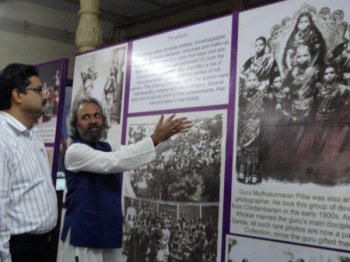 Ashish Khokar
I owe my career as a dance historian, scholar, author and critic to Mohan Khokar, who became my mentor and was a friend, philosopher and guide. I had known the family of Mohan Khokar from 1957 and it was a life long friendship. In 1975, I registered for Ph. D under Anjali Merh, for my researches on Kuchipudi, Bhagavata Mela Natakam and Kuravanji dance-drama tradition with special reference to Rasa Theory as expounded in Bharata's Natyashastra. Anjali had from a young age studied Bharatanatyam under direct supervision of Rukmini Devi and after her marriage moved to Baroda and joined Dance Department to teach Bharatanatyam. Therefore this particular Nritya Parva 2013 held very important significance for me. Both my mentors were remembered. Mohan Khokar's priceless dance collection displayed at the dance department drew a considerable discerning crowd and the Vice Chancellor promised to give full support, if the dance department submitted a proposal to the VC to get land, money for the Museum of Performing Arts under the aegis of MS University and house the Mohan Khokar Dance Collection in Baroda. That would be splendid. One hopes that this collection finds a roof like Dance Collection of New York Public Library at Lincoln Centre, a centre for dance studies. Since the Museum for Performing Arts as planned by Sangeet Natak Akademi has not materialized and is in doldrums, and also the much promised Guru Gopinath Museum at Thiruvananthapuram has run into difficulties with the change of Government, one only hopes that the University can help to have such a museum. It would also attract people to visit Baroda. Seminar & Lec-Dems Parul and Ashish had conceived the Nritya Parva and seminar as 'A fiesta of classical dances of India: Post Independence.' On the opening day during the morning seminar, under the Udayan Arts Series in Dance and Technology (the series was started in 2012 in memory of Udayan Patel, psychoanalyst from Mumbai) Shanta Serbjeet Singh laid stress on dance studies and assured all support for the Dance Collection. The Vice Chancellor advised the different faculties to drown their differences and work harmoniously, suggesting other faculties follow the example of Performing Arts Faculty. Other series was (Late) Nayana Desai Lecture in Dance with donation from her husband Prof. RC Desai, former Dean of Faculty of Technology, MS University. From Kolkata, Aloka Kanungo, a seasoned Odissi exponent and disciple of Guru Kelucharan Mohapatra, gave a talk on development in Odissi in post independent period in India. She referred to various changes which have taken place in Odissi, which according to her had developed in three gharanas: Pankaj Charan Das gharana (Mahari tradition), Kelucharan Mohapatra gharana and Deba Prasad Das gharana. She also showed her concern for Bandha nritya, acrobatic dance as performed by Gotipua dancers, young boys who dress as female dancers and perform Bandha Nritya. She invariably incorporates some elements of Bandha Nritya in her repertoire. Celebrated Mohiniattam exponent Bharati Shivaji, with her daughter Vijaylakshmi from Delhi, explained how she began her studies of Mohiniattam visiting Kerala and learning from Kalyani Kutty Amma and with the help of poet, dramatist, musicologist Kavalam Narayana Panicker expanded the repertoire from what was existing at Kerala Kalamandalam. Vijaylakshmi demonstrated the salient features of Mohiniattam and screened excerpts from their group choreographic works including Swan Lake to the music of Tchaikovsky, and other two works, one in which they used Kalaripayattu movements and one in which they combined Dhak instrument and Edakka using Bengal puja celebration. Also excerpts of 'Bhanusinger Padavali' were screened. It gave the students quite a range of developments in Mohiniattam in post-independence era. This was a very rewarding session as precious little is known about such developments in Mohiniattam in this part of India. Those who live in Delhi get opportunities to see these performances often but for Barodians it was quite an eye-opener. Delhi based Navtej Singh Johar trained in Bharatanatyam at Kalakshetra and also extended his boundaries in dance with his experimental, innovative works in contemporary dance category. He chose to speak on yoga and dance. While he intended to raise questions and make students think and reflect, his asking questions to students while speaking on abhinaya, caused confusion. He asked what dancers concentrate on when enacting abhinaya. None could reply. He said on vibhava and uddipana vibhava etc., in Natya Shastra terminology. What he intended would have been easier for students if he had straight away started explaining his views. The previous evening he had performed a classical Bharatanatyam number to Muthuswami Dikshitar's composition "Meenakshi memudham dehi," which the students had enjoyed immensely and were full of appreciation for his command over technique, so they would have benefitted a lot if he had explained the process of abhinaya, as he visualizes. The third morning was devoted to Manipuri lec-dem by Angabala Ingebum and her sister Vyjayanti who are settled in Bangalore. Angabala has received training in choreography under Maya Rao and has studied at Jawaharlal Nehru Manipuri Dance Academy at Imphal. Her exposition of chali, bhangi pareng, Lai Haraoba movements, dance of Maibi, priestesses were impressive. Some of the students and staff members also joined her for chali movements which gave students understanding of Manipuri movements. Though the Manipuri movements look simple, holding of arms, movements of wrists, fingers and steps (generally not visible with costumes of mirrored skirts) are quite difficult. It would be interesting to have workshops in dance departments of different dance styles. I was asked to speak on dance research and scholarship in post independence era. Since the three day festival was in memory of Anjali Merh and also an exhibition of Mohan Khokar Dance Collection was part of it, I spoke about how I had started research and field work, how I had received guidance from Mohan Khokar, Anjali Merh, and working with legendry gurus like Kelucharan Mohapatra and others, how fortunate I was to watch performances of Balasaraswati and Shambhu Maharaj, my own initiative of dance appreciation courses and Kal Ke Kalakar Festival for Sur Singar Samsad in Mumbai form 1970 till 1980 and how I learnt a lot through their lec-dems on different dance forms. My field work of Seraikella, Mayurbhanj and Purulia Chhau dances and various books I have written over past thirty years, based on field work, interacting with performers, gurus, watching dance, writing as a critic and sheer luck to have received opportunities to travel within India and abroad, teaching as a Professor and Head, Dept of Dance at Rabindra Bharati University, Kolkata, and as a Dean and Professor at School of Arts and Aesthetics at Jawaharlal Nehru University, New Delhi, and my latest book on Sattriya dances of Assam to be published by Marg in March 2013. On account of Google, internet, easy access to information, the reading habits on part of dance students has taken a back seat. Lot of information is available through books already published; lack of initiative for field work and scope for research are major hindrances for sound scholarship. The Universities provide scope for seminars, lectures by visiting professors but there must be a passion for dance, both practical and for knowledge. That can be inculcated by the teachers in the dance departments. The final lecture was by Ashish Khokar, who screened rare clippings of Bharatanatyam as performed by Saroja, filmed by Ram Gopal in London (I happened to be there with Ram Gopal as he was planning to make a film). It brought tears to my eyes. Saroja's dance has been captured magically by the cameramen and it shows the purity of her dance, bereft of glamour and speed, and invariably conveys the spiritual quality. She is a true devotee and one could see it. The experience was rather overwhelming and all gave her and Ashish a standing ovation. He also screened a brief film on Mohan Khokar Dance Collection which covers a wide and staggering range of collection on dance, the only one so rich in terms of rare items. Thanks to Mohan Khokar's advice, I too had started to collect books, program souvenirs, articles, clippings, photos and what have you since 1958. But I gave up as where can one store it, preserve it and maintain it for access to dancers and scholars? Ashish is to be complimented for devoting all his time to looking after this legacy which he has inherited. Having seen that collection and also other collections abroad, mainly at Lincoln Centre in New York, I wish Mohan Khokar Dance Collection finds a similar venue and the young generation can study it, building context in which Indian dance grew, developed and is recorded. The students and staff members were genuinely moved and were grateful to him for bringing it to Baroda where his father had started his career way back in 1950! Ashish said that he gave up completing his PhD studies in order to concentrate on preservation of the dance collection. I think he can do both. If he completes his PhD on whatever aspect of dance he chooses, the discipline of PhD, the writing of thesis and the scientific approach would help him immensely and also open up opportunity to teach at any University and share the collection in a meaningful manner. Performances On the opening night, Parul Shah presented a multi-media dance theatre presentation titled Rajyalakshmi by Anjali Memorial Committee Repertory Company on the establishment of the 'Gayan Shala' in the city to the Faculty of Performing Arts and the MS University of Baroda by Srimant Sayaji Rao Gaekwad III. Rare documentary photographs, visuals, clippings of wars from the films, amazing recordings of Faiz Khan sahib, of visiting artists like Bala Gandharva, his singing and visuals of female roles, Raja Ravi Varma's long stay in Baroda and other special nuggets were wonderful. The script was by Professor Deepak Kannal and theatre design was by Prabhakar Dabhade. It is a well documented production and deserves to be shown all over Gujarat and also elsewhere in India to give a glimpse of the glory of Baroda. With technological advances, the presentation has managed to have good synchronization. I enjoyed it and even though I knew some historical facts, putting them together artistically with visuals was a laudable effort. Abhishap, a new work in progress by Parul Shah and Prabhakar Dabhade originally created, collaborated and performed cross culturally with Javanese American Peggy Myo Choy and Parul, dwelt upon the plight of Draupadi. Vocals were provided by Ashawari Patvardhan with sarangi accompaniment by Ilyas Khan of Music Dept. Since it is a work in progress, it needs to tighten up to make it more effective. 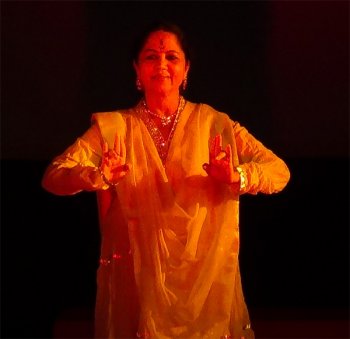 Parul Shah 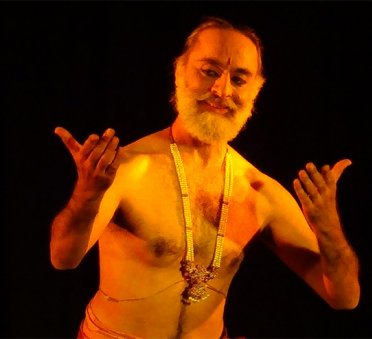 Navtej Johar Navatej Johar's Bharatanatyam indeed cast a spell. He has performed "Meenakshi memudham dehi" many times and I have seen it. But watching it this time I could see that he had incorporated some elements of yoga, dhyana and esoteric practice in some passages. He told me later on that Muthuswami Dikshitar was a Shaivite bhakta and therefore he incorporated some of those elements in his interpretation. Navtej uses green colour in one sequence by placing his palms in a thali full of green colour. The green coloured palms look exotic. There are references to green colour in text also. Meenakshi's birth as Pandya Raja Malayadhwaja's daughter, born of fire, with three breasts, with akashvani that when she will meet her beloved Lord Shiva, the third breast will fall was enacted with suggestive and minimal abhinaya. Meenakshi's valour, expertise in archery, as a warrior princess etc were more in nature of suggestion. Navtej said that the moment he listened to the music for the first time, he was deeply stirred and since then he has explored the piece and loves to perform it. There is a palpable intensity in his presentation and complete involvement which transcends mere physical dance. The audience often clapped for his energetic execution of teermanams which were forceful and not like cartwheels with arm arching over head. The sound training over years at Kalakshetra was evident and has stood him in good stead. As a Sikh, with beard, he performs with such integrity that he looks like a yogi. The performance gave one a trance like experience. On second evening Aloka Kanungo began with trikhandi pranam with an Odiya composition penned by her. Though of diminutive height, Aloka has an expressive visage and registers emotions in a telling manner. Popular Banamali Odiya pada 'to lagi Gopa danada manare Kaliya suna' - O Krishna, on account of you I am unable to go to river to fetch water - choreographed by Guru Kelucharan Mohapatra remains an evergreen abhinaya piece. Aloka danced it with joy and alternated the roles of Krishna and gopi. In the stanza 'sharam to mukhe nahi re Kaliya maram katha' she disengages her arm, gets into her home and closes the door. Aloka had choreographed the pallavi which had the usual sculpturesque movements. However, in some poses, Aloka seemed to be unsteady. She would do well to plant her feet on the floor with swastika pada and it will still retain the beauty of sculptures. In Gita Govinda ashtapadi 'Sakhi he Keshi mathanamudaram,' when Krishna with sweet nothings mesmerizes her and has union with her, 'Shatai chatu vachananukulam, shithilikrita jaghanadukulam,' Aloka with restraint expressed bashfulness telling her Sakhi, the experience of first meeting with Krishna. Prathama samagama lajjitaya sakhi, during the first meeting overcome by shyness, the delineation was appropriate. It is one of the finest ashtapadis choreographed by Kelucharan Mohapatra. Aloka performed it with fidelity to her guru. Moksha incorporating sabdaswarapata, kavit like compositions in Odissi and the Dashamahavidya, iconographic depiction with emphasis on Goddess Kali, was another interesting number Aloka had explored. Her Odissi is of Guru Kelucharan Mohapatra gharana and she does justice to that gharana. 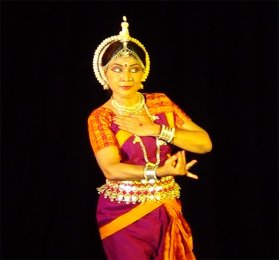 Aloka Kanungo 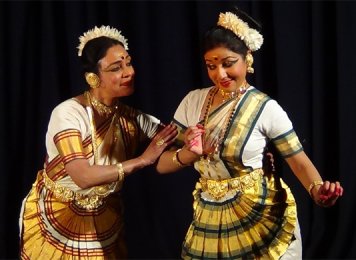 Bharati Shivaji & Vijayalakshmi Mohiniattam by Bharati Shivaji invariably succeeds in bringing out the inherent slow unfolding of graceful movements of Mohiniattam form. Prayers to Ganapati and Saraswati built up the mood for other numbers to follow. The duet by Bharati and daughter Vijayalakshmi based on Gita Govinda ashtapadi Dhira samire, Yamuna tire, vasati vane vanamali, showed both of them in their elements. Perfect synchronized movements as an expressive dialogue, Sakhi telling Radha about Krishna waiting for her in his bower and asking her not to delay, leave tinkling ankle bells and go unto Lord Krishna, who even when a dry leaf falls from the branch of a tree, gets startled thinking Radha has arrived. 'Patati patatre, vichalita patre, shankita bhava udyanam,' put on a dark veil and go, both Bharati as a Sakhi and Vijayalakshmi as Radha enacted the roles with consummate artistry. In a lullaby, Bharati expressed motherly love for her son, comparing his physical beauty with full moon, fully blown lotus and considering them not up to his beauty, cajoles him to sleep, slowly pushing the cradle. The child falls asleep and she leaves the stage, when the audience claps, Bharati returns and signals to the audience not to clap as the baby is asleep! This ploy always works and audience loves it. In the finale, Vijayalakshmi performed to a musical score composed by an American musician echoing the sentiments she said she wished to portray. It was quite a remarkable feat and the fusion worked considerably winning the well deserved applause. Both dancers indeed charmed the audience away with their excellent chemistry dancing together. They have arresting stage presence and create illusion of Mohinis! On the final evening, Dance Department's disciple Divya Patel gave a brief Bharatanatyam recital. A Gold medalist, well trained Divya proved her mettle with a flawless performance. Despite her avoirdupois, she danced with lightness, executing movements with precision. The ashtapadi from Gita Govinda evoked the mood, dance of Krishna with other gopis in an engaging manner. Tillana always wins applause and appreciation from audience. Vocal support from Mumbai based musician PH Ramani of Natanapriya Academy of Fine Arts and nattuvangam by Parul Shah and Ami had the customary finesse. 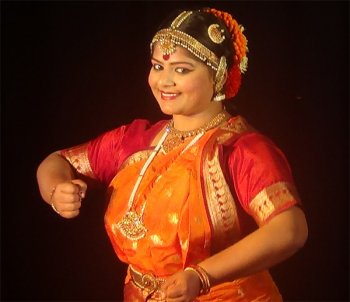 Divya Patel 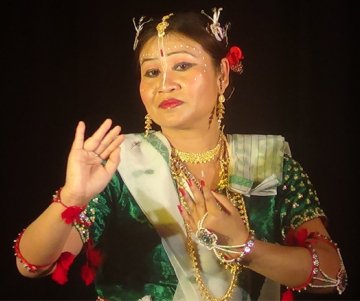 Angabala Ingebum Manipuri by Angabala had a nostalgic touch. Guru Amubi Singh's choreography of Nilakamaladala Shyam specially composed for Amala Shankar, wife of legendary Uday Shankar, in its Meitei translation has become a classic. Angabala performed it with complete involvement and typical Manipuri movements, petal soft foot work, graceful bhramaris, with emphasis on angikabhinaya, as mukhajabhinaya is not pronounced in Manipuri. Along with her sister Vyjayanti in role of Krishna, she as Radha in gorgeous Manipuri costumes, Radha with mirrored skirt, gossamer veil and Krishna with peacock crown, pitambar and green velvet garment created Manipuri ambience in Basant Ras. The aharya element on Manipuri is exquisite and adds to the visual appeal. Both acquitted themselves well in their presentation. The finale was MSU video clipping of three choreographic dance presentations specially choreographed for the First MSU Alumni meet held on January 5, 2013 that had brought together for the first time all degree students of Bharatanatyam and Kathak who performed together creating a vibrancy of movements, colour and amazing energy. To witness this mega event, almost like a large television reality show, with flickering spotlights and camera focusing at times on feet, at times sweeping shot of collective dancing with students cheering loudly was infectious in mood. Padanyas choreographed by Jagdish Gangani and other group dance by Parul Shah, with dexterous combination of Bharatanatyam and Kathak movements looked very impressive. I was in Bangalore attending Prof US Krishna Rao's centenary celebrations, so when I was invited for the first MSU Alumni meet, I had missed the celebration. Therefore, watching it on screen, I was impressed with choreography on part of both Parul Shah and Jagdish Gangani. I joined the enthusiastic applause of the students for the screening. Anjali Merh memorial event was a part of Maharaja Sayaji Rao's 150th anniversary celebrations. Anjali Memorial Committee with support from the Vice Chancellor Yogesh Singh, Dr. Jyoti Pandya, Mayor of Baroda, Rajendra Trivedi, MLA, NV Patel, former Mayor of Baroda, educationist and Bharatanatyam exponent Tejal Amin and others succeeded in offering a fitting tribute to Anjali Merh with this memorable three day event. Being a former student of Dance Department, Faculty of Performing Arts, MSU, I felt privileged to be a part of the festival.  Dr. Sunil Kothari is a dance historian, scholar, author and a renowned dance critic. He is Vice President of World Dance Alliance Asia Pacific India chapter, based in New Delhi. He is honored by the President of India with Padma Shri, Sangeet Natak Akademi award and Senior Critic Award from Dance Critics Association, NYC. He is a regular contributor to www.narthaki.com, the roving critic for monthly magazine Sruti and is a contributing editor of Nartanam for the past 12 years. Post your comments Pl provide your name and email id along with your comment. All appropriate comments posted with name and email id in the blog will also be featured in the site. |